- Getting around Lijiang. Dont stay in the Old Towns more than 2 days, there is nothing to do. KRISS Oct 9, 2013 05:46
- 2013 Beijing Temple Fair BENNYLAU Feb 26, 2013 03:29
- Malaysian traveling from KUL - LAX vis Shanghai PVG ZATI_DY Jan 3, 2013 20:15
The Hidden Sanctuary: Part 1
- Views: 6036
- |Vote: 2 0
- |Add to Favorites
- |Recommend to Friends
Between the Giants of Industry
Sandwiched between two of China’s largest cities, over 200 square kilometers of ancient natural beauty stretch unobscured to the heavens. There’s no competing with skyscrapers around here as the mountains corrugate to the horizon, though these hills, due to light pollution, must be missing their evening parlance with the stars. As Beijingers and Tianjiners bustle about their daily lives and plan their monthly or yearly vacations, many of them have no idea that an escape from city life needs hardly any planning at all.
88 kilometers south east of Beijing and 110 kilometers north east of Tianjin lies an oft-overlooked chunk of land host to over 8 mountain peaks, a long slithering portion of the Great Wall, one of the oldest wooden structures housing a 16-meter tall statue of the Buddhist goddess Guanyin, one National Forest Park and a National Nature Reserve.
The area is called Ji Xian, or Ji County, the northernmost county of Tianjin’s province. The central town is usually referred to as JiXian but was historically known as YuYang. The mountain parks, nature reserve, and Great Wall starfish around the town center. Trains or buses from Beijing or Tianjin will arrive in downtown JiXian and local buses or tour buses are then available to take visitors to any of the desired destinations, whether it’s Pan Shan, Mt. Ba Xian National Nature Reserve, Jiu Long Shan (Nine Dragon Mountain) National Forest Park, Huanyaguang Great Wall, or the Dule Temple.
Pan Shan
Twenty kilometers northeast of JiXian’s downtown sprawls the five-peaked scenic area of Mount Pan, or Pan Shan. It’s known as the “First Mountain East of Beijing” and is listed as one of the top 15 mountains in China, though it bears its fame with modesty. Indeed, I ended up at its foot almost unintentionally, though once there I was taken in by its beauty immediately.
Pan Shan is unique in its vistas and character. The peak itself isn’t awe-inspiring, stark, cragged, or steep. Its wonders lie in their discovery, in the modest way your eye connects with the little pockets of beauty that expose themselves as you ascend the 5-peaked sentinel. Indeed, like life itself, you traverse the highs and lows, each time getting a bit higher and discovering a bit more. Pan Shan is home to over 320 different kinds of trees and shrubs, which are helpfully identified by signs. One species is known to the Chinese as SongBai, which are personified and emulated, due to their ever-green foliage, as morally stable, high-minded, eternally good, and fair. Another species is known as FengSong, or the Phoenix Pine, which writhe like phoenixes twisting and reaching from the roots of the earth toward the sun. These pines grow in such a peculiar, unique way due to the dry, loose topsoil that dusts the flanks of Pan Shan.
Cragged Fretwork
Pan Shan is also known for its rugged and abrupt rock outcroppings and formations which braille the multiple trails and paths that meander toward the summit of the mountain. Many have inspired poets who have traveled to Pan Shan since the Tang dynasty (618-907), and religious ascetics who built over 70 temples and pagodas within the mountain’s embrace. Residential monks can still be met upon the paths, which makes one feel as though they’ve trespassed upon something sacred. The breeze almost seems to whisper prayers as it slips through the boughs of trees, adding an ethereal harmony to the monks’ rhythmic chanting outside temples and the bass-line babble of streams and waterfalls.
Ascension
There are four main temples on Pan Shan which punctuate the ascent up the mountain. One-quarter of the way up delivers one to Tian Cheng Si, the God-Proposing Temple, which sits beside a small pagoda said to cradle sacred relics and and bones. Mid-mountain, after a breath-takingly steep pitch of mountainside, one arrives at the Wan Fo Si, or the Ten-Thousand Buddha Temple, whose sight makes it difficult to catch one’s breath. From mid-mountain to the summit there’s the option of taking a chair-lift, which is tempting after the steep climb to mid-mountain, though expensive (50RMB for one person, round-trip).
The summit of Pan Shan is known as Guayue, or Moon Hanging Peak. It pokes up a modest 864 meters, but its perch and the views that sprawl beyond it don’t belie the name. One literally feels the moon may be hung from the top of this gorgeous summit, and on a clear day the Great Wall can be seen ramparting the hill to the north while to the west Mount Taihang is visible.
Local Charm
At the base of Pan Shan operates a bustling micro-economy, a mini-market where local wares and fruits of the earth, literally, can be purchased. Dried nuts and fruits, seasonal fruits, sundries and trinkets are piled up stall after stall. Figs and peaches and persimmons look mouth-wateringly ripe and sweet, balancing the salty richness of Chinese macadamia nuts, walnuts, pine nuts and hazelnuts, to name a few. There are also several kinds of mushroom and dried meats and root vegetables, as well as potatoes and yams.
Sellers also hawk a special kind of bracelet, necklace, and ornament sculpted and honed from peach pits, in abundance in this area from the peaches that grow locally. It is auspicious to buy this bracelet or ornament for a lover, as the peach is known to bring balance and peace and healing. Strung with a bright red thread, this modest jewelry is striking in its earthiness and simplicity.
"Had I known..."
Emperor Qianlong, of the Qing dynasty once ended up at Pan Shan on a break from his journey to his family home somewhere south. After his first trip to Pan Shan he is reputed to have heaved a great sigh and said “Had I known Pan Shan earlier, I would not have taken the trouble to travel down to the south” where mountains and natural scenery of greater renown lie. Emperor Qianlong made several trips to Pan Shan after that first transcendent visit, so many so that he had his own quarters built in the Dule temple complex in downtown JiXian, which tourists can still visit today. I’m sure I’ll follow in the great Emperor’s footsteps, as Pan Shan’s sprawling environs keep beckoning visitors back into its fold.
Travel Information
Late Spring, Summer, and Autumn are the best times to visit.
Trains leave from Tianjin daily at 730 and depart from JiXian at 1900. Tickets cost 20RMB. From Beijing, inquire at the train station or a travel agent.
Buses also run from Tianjin’s north east long-distance bus station. From Beijing, inquire at the long-distance bus station or a travel agent.
Local buses and tourist buses run from the JiXian station to the base of Pan Shan. Prices vary, but are cheap.
Pan Shan entrance ticket: 40 RMB
Chairlift: 50 RMB/round trip. 25/single trip.
Operating Hours: 900 to 1700
Hotel Information
In JiXian town the Yuyang hotel just north of the Drum Tower offers comfortable double rooms for 150 RMB. There are also cheaper options within the town and small chalets on the mountain. Rates vary seasonally.
Eating
There are plenty of local restaurants in JiXian town. There are also some restaurants on the mountain itself. These places all use local fresh ingredients and are fairly cheap.



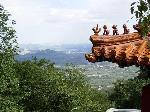
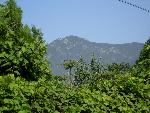
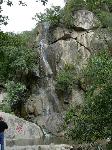
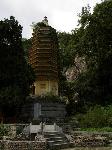
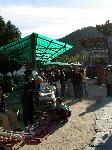

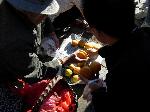
 Copyright © 1998-2025 All rights reserved.
Copyright © 1998-2025 All rights reserved.